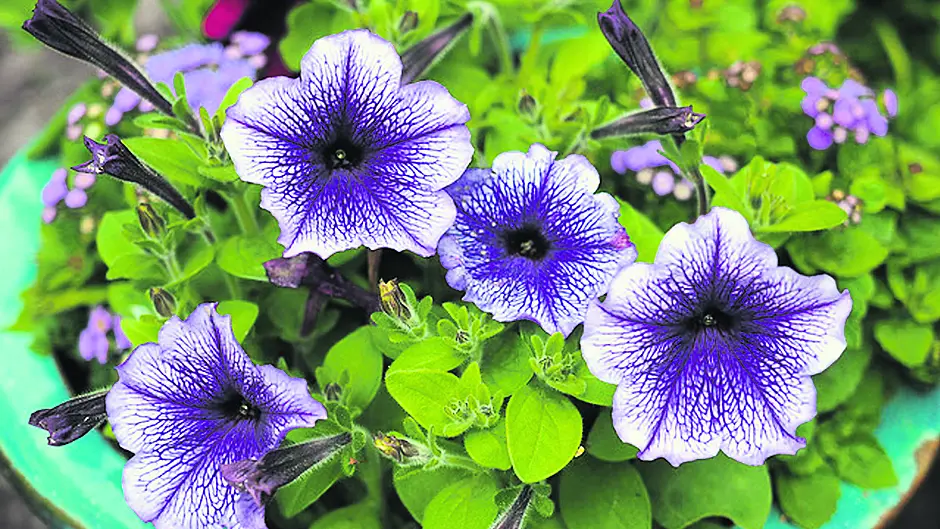Gardening with Joyce Russell
MAY has been lovely so far but gardeners have had to contend with some low night temperatures and a few frosts too in some areas. The ground seems to have been warm enough to stave off damage from these temporary drops and covering tender plants on cold nights helped keep them safe. Hopefully, we have seen the last of the really cold nights now for a good few months.
Lack of rain has also brought problems – I try to avoid watering the outdoor garden if possible and prefer to use mulch to keep moisture in the soil, but there always comes a point when some water is needed if we don’t get enough rain. Small plants don’t have deep root systems and they can’t thrive in dry soil. Rhubarb stems tend to flop and clumps push up flower stems if the ground dries out and both onions and garlic need plenty of water if they are to make decent sized bulbs. Pea and bean rows need lots of water when they are in flower and any soft fruit needs water too when swelling berries.
Try to conserve water if the next few months bring a drought. Re-use what you can and prioritise watering the plants that need it most. The ideal situation, of course, is to get night time rain or short daytime showers that wet the ground enough to support grass and garden growth.
Growing under cover
Large aubergine and pepper plants are ready to plant out in the greenhouse and polytunnel. These plants don’t like cold so put an extra cloche over the top until night temperatures are above 12C. Open the cloche by day and open polytunnel/greenhouse doors and windows too – all plants need good ventilation if they are to avoid moulds and mildews.
Cucumber plants grow fast and they need a little care – tie strings to the frame of the greenhouse and twist stems gently around so they grow upwards. Make sure to use strong enough string so it doesn’t break under the weight of lots of fruit. If you see surface roots growing from plants, then add a layer of compost around the stem. This provides extra nourishment without burying roots too deep in the ground.
Tomato plants are growing well and many have opened first flowers – mist these lightly with water so pollen is just damp enough to set fruit, but not so wet that it washes out. You won’t need to do this after some first fruits set, but it is a way to help get full lower trusses. Keep tying stems into support strings, poles, or canes as the plants grow. Remove any side-shoots (unless you are growing bush varieties) – take these out cleanly so you don’t leave a ragged wound.
And remember that it’s not just these familiar plants that can be grown in a polytunnel or greenhouse. If you have the room, then try climbing French beans, sweetcorn, lots of summer salad and basil – all of these plants thrive in a protected environment.
Containers full of flowers
Many flowers bloom really well in large containers, but some only flower for a few weeks. The secret to containers full of flowers over several months is to follow a few simple tips:
• Choose plants that are suited to containers and flower over a long period. Read the labels or ask advice if you are unsure what to get.
• Replant as needed. Tip out the entire rootball when early bulbs finish flowering. You can plant this permanently in a garden bed or lift it again to go back into a container in the autumn. Some bulbs can perform well for several years in this way. You can also lift individual plants from a mixed container if they are past their best – put in something new to enhance the rest.
• Don’t be too precious! Many supermarkets and garden centres (hopefully open now) sell a good range of container plants and they don’t cost very much if you want to experiment. If you haven’t paid a fortune for a plant then you can afford to take a few chances and ring the changes. See what combinations you like, and what does well, and don’t turn your nose up at some old favourites like petunias and geraniums. These can make lovely displays if you choose your colours and position them well.
• Keep the compost damp. You may need to water every day, or even twice a day for some thirsty plants if conditions are hot and dry.
• Use a liquid feed every 10 days or so when plants start to flower.
• Remove dead flower heads. Plants look nicer and it helps them produce more new flowers.
• Provide support sticks or frames if needed. Tall stems may break and you can lose whole flower stems in a strong wind.









